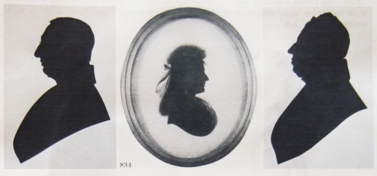Hervé, Charles II (SCC Newsletter September 2010)
Charles Herve II 1785—1866
An attempt to look at the work of this gifted prolific artist and fine copyist—and that of the Prosopographus Gallery that he ran for a number of years.
 This is a black and white reproduction of a miniature by Herve of Miss Croker— adopted daughter of John Croker after a portrait by Sir Thomas Lawrence, illustrated by Arthur Mayne in "British Profile Miniaturists". It is illustrated at the head of this article to show that Herve had without doubt artistic skills—not possessed by many of his contemporaries!
This is a black and white reproduction of a miniature by Herve of Miss Croker— adopted daughter of John Croker after a portrait by Sir Thomas Lawrence, illustrated by Arthur Mayne in "British Profile Miniaturists". It is illustrated at the head of this article to show that Herve had without doubt artistic skills—not possessed by many of his contemporaries!
"No figure appears more often in the literature on nineteenth century silhouettes than that of Charles Herve II, miniature painter, silhouette artist, professor of music, manager of the Prosopographus Gallery and fruit grower." This is a quote from the first paragraph of Mrs McK's entry on this artist (p.232-233). Therefore, it is strange that I have only just got around to looking at his work after some fourteen years of producing the S.C.C. Newsletter! Further, it is even stranger that so few of his authenticated silhouettes have turned up in the salerooms over the years, as his output for the period he worked went into the thousands.
In view of Mrs McK's quote it seems appropriate to look at the literature before describing the artist's background and looking at his silhouette career. Mrs McK. in her Book has entries for him in Sections One, Two & Six—the main entry being in Section One, which relates to cut-outs. Also, in Appendix Three she has a list of the numerous members of the Herve family—in an attempt to sort out the family relationships and to identify those members, who contributed to the art of the silhouette. This latter ‘exercise' was also attempted by Daphne Foskett in her Dictionary of miniature artist—in this she named twelve members of the family who may have contributed to the art of the miniature. There is little doubt that the family had many artistic skills.
Mrs Jackson has an entry in her Dictionary, but gives no illustrated examples of his work. John Woodiwiss in "British Silhouettes" has a brief reference in which he expresses his admiration for the artist's work —he illustrates this with a full-length example. Arthur Mayne in ''British Profile Miniaturists" has an entry under minor artists that is largely a crib from Mrs Jackson but he does illustrate a full-length silhouette in colour of a lady with a harp attributed to the artist. (This will be illustrated later in this article.) Mrs Peggy Hickman does not mention him in any of her books, although she did have works by him in her collection.
However, the most interesting entry is from Desmond Coke in "The Art of Silhouette". ln this he places Herve's "gold embellishments " on a par with those of J. Field and The Royal Victoria Gallery. He provides an illustration of a full-length gent (in b. & w.) to show this.
C. Herve Page 2
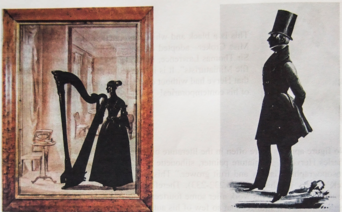 I have illustrated below the lady with the harp from Arthur Mayne's book and the gentleman from Desmond Coke's "The Art of Silhouette". The gilding on the latter figure is all on his right side to give the effect of light coming in from that side— possibly through a window that is not shown. Also, note the shadow-lines and the small tuft of foliage on the same side—these seem to be a feature of Herve's full-length work. The foliage is very reminiscent of many of the works from the Royal Victoria Gallery. The lady with the harp has a very detailed painted background—it is possible that this was painted by Herve himself. Mr. Mayne does not mention a signature or label on the work and does not relate how it has been attributed to Herve. It is interesting that Mrs McK. does not mention this work in her Book, although Mr Mayne was published before her great work. Let us hope that Mr Mayne's attribution was correct.
I have illustrated below the lady with the harp from Arthur Mayne's book and the gentleman from Desmond Coke's "The Art of Silhouette". The gilding on the latter figure is all on his right side to give the effect of light coming in from that side— possibly through a window that is not shown. Also, note the shadow-lines and the small tuft of foliage on the same side—these seem to be a feature of Herve's full-length work. The foliage is very reminiscent of many of the works from the Royal Victoria Gallery. The lady with the harp has a very detailed painted background—it is possible that this was painted by Herve himself. Mr. Mayne does not mention a signature or label on the work and does not relate how it has been attributed to Herve. It is interesting that Mrs McK. does not mention this work in her Book, although Mr Mayne was published before her great work. Let us hope that Mr Mayne's attribution was correct.
Now to look at what we know about Charles Herve's background, his working career, his silhouette style and the running and management of The Prosopographus Gallery—together with illustrations of his work from the literature and private collections.
Family Background.
Charles Herve married a lady called Charlotte and they had two sons—named Charles Herve III and Edward L. Herve. Neither earned their living as artists. Mrs McK. in her account states that these two were probably Charles's sons, but she cannot be sure! The family relationships in the Herve family remain something of a ‘mystery' it seems! Equally Alfred Herve II, who was a silhouette artist, was probably a nephew.
The family seem to have moved about a bit—this was complicated by Herve's use of so many different addresses for his working studio. It is impossible to sort out his home address from that of his work place at different stages of his career. For a time, the family certainly lived in Paradise Place, Stockwell - in fact at numbers 2 & 21. This was a fruit growing area, which fits-in with Herve giving the occupation of "fruit grower" in the 1841 census. We do not know the family's address for either the 1851 or 1861 census. All addresses on his trade labels (which I will illustrate later) were in central London—it is doubtful if these were where the family lived.
C. Herve Page 3
His Professional Career
It is not clear when Herve started cutting and painting silhouettes—this was possibly about 1810 or so. However, we do know that he did not paint or cut any after 1848—although it is likely that he continued to paint miniatures after that date. We know that he started The Prosopographus Gallery in 1818 and that this functioned until the late 1820's. Also, he was associated with another silhouette enterprise called The City Portrait Gallery. Not much is known about this Gallery—except that it was running in the 1850's—but there is no evidence that Herve produced silhouettes for it. It seems that Herve had his fingers in many pies!
It is very likely that Herve was cutting silhouettes before he opened The Prospographus Gallery in 1818, as he would have been 33 years old by then and presumably had some confidence by this stage in his career that he had the abilities to risk opening a gallery, which would employ assistants and travel around the country. Bearing in mind that there were a number of similar 'outfits' doing the same thing at the time. Herve seems to have had a longer career painting miniatures then the one he had with silhouettes— as he is recorded as exhibiting at the Royal Academy from the years 1828-1858.
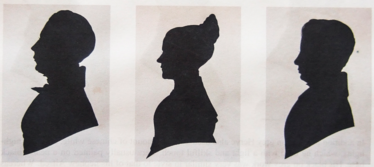 As mentioned his studio addresses were numerous. We have some dates for these, which cover the period 1828 to 1858, when he was only likely to be painting miniatures. These addresses are all in central London, where no doubt many other artists were working at the time. He worked at 128 & 329 Strand, 138 & 248 Regent Street, 172, 193, 210 & 256 Oxford Street. Some of his recorded stencil labels give these addresses—some give two addresses on the same label. The most used address seems to be 145 Strand—this is stamped on the back of each of the silhouettes illustrated above.
As mentioned his studio addresses were numerous. We have some dates for these, which cover the period 1828 to 1858, when he was only likely to be painting miniatures. These addresses are all in central London, where no doubt many other artists were working at the time. He worked at 128 & 329 Strand, 138 & 248 Regent Street, 172, 193, 210 & 256 Oxford Street. Some of his recorded stencil labels give these addresses—some give two addresses on the same label. The most used address seems to be 145 Strand—this is stamped on the back of each of the silhouettes illustrated above.
All three are plain cut-outs. All are from an album I bought some years ago. On the left is George J. EIlison. In the centre is his wife Mrs Ellison. On the right is Robert Sutherland and he is dated 24th. February, 1839. All have a very delicate eyelash, which has clearly been applied with a one hair brush, I think! It is very difficult to ‘feel’ the cutting on the surface of the backing card in the case of all three—as this has been stuck with great skill. It is of interest that all the works by Herve in my album (of which there are about 12 in number) all face to the left.
C. Herve Page 4
His Style.
Below are illustrated three more examples from my album—all three are painted, but two have highlights to show clothing detail. On the left is the Rev. I. M. Thomas—in the centre is the Rev. Cyril J. Page and on the right is N. Smedley Esq. The clothing detail is difficult to show, but it is very skilfully painted in black on a very dark grey base colour. Grey water colour has been used to portray the shirt collar and stock. Also, a very delicate brush has been used to show hair outside the main body of the silhouette.
Clearly most of Herve's output of bust-length works would have been cut-outs in plain black—the outlines of which he obtained by a machine that he had invented. He called this machine eventually "The Automaton Artist”. He gave great publicity to it when he set up The Prosopographus Gallery. I will describe the machine in more detail later, when looking at the work of that Gallery.
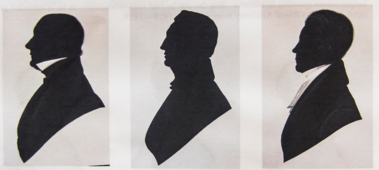 In addition to black on grey Herve also used a small amount of chinese white. His gold high-lights, which he used with a light and skilful touch, were usually painted on a nearly black base. His black on grey work was very similar in style to that of his nephew Alfred. Whereas his gold on a grey or black base was very like the work of Mrs Smythe (or Smith) in the skill and delicacy with which the strokes were applied. As I have indicated his cut-outs are almost impossible to detect even with a finger touch— this is further complicated by the fact that his plain black painted work is exactly similar in style. Under glass one could only guess which was which.
In addition to black on grey Herve also used a small amount of chinese white. His gold high-lights, which he used with a light and skilful touch, were usually painted on a nearly black base. His black on grey work was very similar in style to that of his nephew Alfred. Whereas his gold on a grey or black base was very like the work of Mrs Smythe (or Smith) in the skill and delicacy with which the strokes were applied. As I have indicated his cut-outs are almost impossible to detect even with a finger touch— this is further complicated by the fact that his plain black painted work is exactly similar in style. Under glass one could only guess which was which.
John Woodiwiss refers to work by Herve on plaster—as does Mrs Jackson, as she had seen such an example in the collection of the late "George Stoner’. However, Mrs McK. did not have an entry for the artist in her paster section—so she must have taken the view that these authors were mistaken!
Herve was a fine copyist this is demonstrated by the copy of a Miers lady on card (more likely to have been a Field), which he probably painted when working for a short time with William Miers, after he split-up with John Field. I suppose it is possible during this time that he painted on plaster as well, but Mrs McK. did not consider this. His copying skills may account for the fact that his style is almost impossible to attribute without a label. The question is—did he successfully develop bis own unique style? I think perhaps he did not in spite of his undoubted talents. It is likely that there are many examples of his work, where the backs have not been ‘investigated’ and have been attributed to other artists.
C. Herve Page 5
Below are three more examples of Herve's bust-length work. On the left is the Rev. J. Mackie from the album. I think the original owner knew a large number of clergymen! He is painted and it should be possible to see the outline of his spectacles that have been painted with a one hair brush and with great control In the centre is the copy of the Miers silhouette to which have referred—this was sold at the Willcocks Collection Sale at Phillips on 10/11/98 and is also illustrated in the Book on page 486 illus. 834. On the right is a silhouette of N. L. Thomas Esq F.R.S. from my album—it is a cut-out.
Bust-length terminations.
These are generally of the long sloping variety—some of the slopes are longer than others. Mrs Mc.K. mentions a "concavity near the junction of the arm," but this is not evident on the examples illustrated so far.
Below are two further examples—both from the Book. On the left is Marianne Noble—a cut-out with black and chinese white highlights to show clothing detail. On the right is an unknown older lady—also a cut-out, but this time with fine pencilled gilded clothing detail. Both these examples need to be in colour to show to advantage the skill of the artist. Both
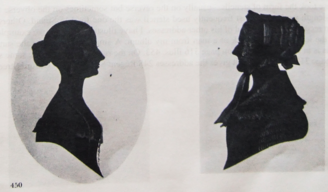
C. Herve Page 6
His full-length works.
I have illustrated two examples from the literature earlier in this article. Below are two further examples. On the right is "The Spinster Aunt" - a cut-out with a dark grey base colour and embellished in black. She is in the Book page 153 illus. 221 and is also illustrated in John Woodiwiss's "British Silhouettes" illus 52. On the left is a familiar young boy. He was sold at the Pollak Sale at Bonhams on 21/2/1996 lot 45 and is in the Book on page 177 illus. 257.
I have mentioned the shadow lines and the clump of foliage—the latter is not shown with the "Aunt", but I think it is likely that she was portrayed indoors. Herve's full-length works tend to be somewhat larger than those of other artists of the period. The "Aunt" is 10" X 6. 33" and the boy is 8" X 6".
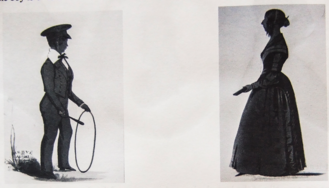 Desmond Coke mentions full-length work in a brown base colour to which gilding had been added of "such a glow as to seem almost transparent—giving light like Nijinsky's arms in "The Blue God." Perhaps he was a little carried away! To quote further from Coke—whilst he greatly admired Herve's gilding skills he did not think that the adding of these additions "improved either the truth or the decorative charm of his portraits yet at its best it does gain an effect of intimacy……..”
Desmond Coke mentions full-length work in a brown base colour to which gilding had been added of "such a glow as to seem almost transparent—giving light like Nijinsky's arms in "The Blue God." Perhaps he was a little carried away! To quote further from Coke—whilst he greatly admired Herve's gilding skills he did not think that the adding of these additions "improved either the truth or the decorative charm of his portraits yet at its best it does gain an effect of intimacy……..”
His trade labels.
 These Look the form of stencils—usually on the reverse but sometimes on the obverse with a full-Length work. The most frequently used stencil was the one for 145 Strand. Others have been recorded using several of his other addresses. I have illustrated below two examples. On the left is from the back of a man from my album. A similar example for the same address is in Mrs McK's book on page 316 illus. 453. On the right is also from the same source on page 317 illus. 454 and it gives the addresses 248 Regent Street & 172 Oxford Street.
These Look the form of stencils—usually on the reverse but sometimes on the obverse with a full-Length work. The most frequently used stencil was the one for 145 Strand. Others have been recorded using several of his other addresses. I have illustrated below two examples. On the left is from the back of a man from my album. A similar example for the same address is in Mrs McK's book on page 316 illus. 453. On the right is also from the same source on page 317 illus. 454 and it gives the addresses 248 Regent Street & 172 Oxford Street.
C. Herve Page 7
The Prosopographus Gallery – The Automaton Artist
 On the left is a handbill or advertisement used by the Gallery—probably dated about 1828. It is from the Book on page 336 illus. 556. The picture is of the Automation Artist which i will describe later.
On the left is a handbill or advertisement used by the Gallery—probably dated about 1828. It is from the Book on page 336 illus. 556. The picture is of the Automation Artist which i will describe later.
It is likely that the Gallery was in operation from about 1818 until 1830. It was managed by Charles Herve II — although when Mrs Jackson wrote her "Dictionary" in 1938 the connection with Herve was not known, although she had an entry on the Gallery (p. 137). Herve was the inventor of the Automaton Artist, which concealed the prosopographus that produced the outline of the silhouettes. As you will see from the above it was in the form of a figure dressed in exotic clothing. The operator looked through the eyes of the figure whilst the right hand drew the profile outline in one uninterrupted line. The client was then presented with this outline when he or she could opt for a fill-in either in plain black or with embellishments. Payment would be charged accordingly. It was claimed that this machine produced "a more perfect resemblance than any living artist can possibly execute."
Plain cut-outs produced by the Gallery were likely to have been done by Herve's assistants. It is equally likely that Herve himself was responsible for painting any highlights and clothing detail. As the outline only took less than a minute to produce, the client could be in and out of the booth in a very short space of time — so a great many must have been produced as the Gallery travelled around the country. A plain black fill-in would cost 1s. — Coloured variations could cost up to 7s. 6p. Clients were assured that the figure in Spanish costume would not need to make any physical contact!
The Gallery travelled widely and claimed to have produced many thousands of silhouettes. It worked from “9 in the morning until 9 in the evening” or “10 until dusk.” Its billing posters were flowery and no doubt exaggerated in their claims — tending to describe the Automaton Artist as a magical object leading to enchantment!
The Gallery opened in London at 161 Strand. It visited Liverpool (1821), Newcastle (1826), Huddersfield (1827), Bath & Bristol (1829) and Cheltenham (1830) In between these visits it operated in central London — in Bond Street and a number of addresses in the Strand.
C. Herve Page 8
 On the left is a boy from Mrs. McK’s book on page 336 illus. 554. The little girl in the centre has appeared twice for sale at Bonhams in the last ten years. Firstly she appeared on her own on 2/7/01 as lot 13 and secondly on 4/3/03 as lot 33 combined with the lady on the right. The lady on the right looks like a work by Alport but was catalogued as being by the Gallery. The boy is a cut-out and the other two are painted.
On the left is a boy from Mrs. McK’s book on page 336 illus. 554. The little girl in the centre has appeared twice for sale at Bonhams in the last ten years. Firstly she appeared on her own on 2/7/01 as lot 13 and secondly on 4/3/03 as lot 33 combined with the lady on the right. The lady on the right looks like a work by Alport but was catalogued as being by the Gallery. The boy is a cut-out and the other two are painted.
The Gallery claimed to have taken George IV, Mr. Canning (prime minister in 1827) and Sir Walter Scott, but Mrs. McK took the view that it was most likely that Herve had used his copying skills to ‘crib’ the images from other artists!
As can be seen from the three illustrations above and the three further illustrations below – work of any style can be found with the backing of a Prosopographas Gallery label!
 On the left is a gent from Bonhams Sale on 24/9/2004 (lot 9). He is a cut-out with bronzing against a sepia base colour with touches of Chinese white. He is nicely and skilfully painted. In the centre is a lady from a Collection – she is a cut-out (although it was very difficult to tell even with ‘feeling’ over her surface.) Her clothing highlights are in gold, which have been delicately applied. She could easily be attributed to the works of Mrs Smythe on stylistic grounds. On the right is a gent painted with bronzed highlights on a dark grey base colour – he is also a cut-out. I mentioned the lady on the top row as looking like a work by Alport – this was due to the lines under the bust-line terminations and the style of the work as a whole,
On the left is a gent from Bonhams Sale on 24/9/2004 (lot 9). He is a cut-out with bronzing against a sepia base colour with touches of Chinese white. He is nicely and skilfully painted. In the centre is a lady from a Collection – she is a cut-out (although it was very difficult to tell even with ‘feeling’ over her surface.) Her clothing highlights are in gold, which have been delicately applied. She could easily be attributed to the works of Mrs Smythe on stylistic grounds. On the right is a gent painted with bronzed highlights on a dark grey base colour – he is also a cut-out. I mentioned the lady on the top row as looking like a work by Alport – this was due to the lines under the bust-line terminations and the style of the work as a whole,

C. Herve Page 9
This pair was sold at the Redpath Sale at Tennants on 2/4/2009 (lot 1234). The work was attributed to Mrs. E. Smith (or Smythe). However, the new owner found subsequently that there was a Prosopographus Gallery label on the reverse, under some backing paper.
The Gallery labels
Mrs McK. records four labels, but only illustrates Nos.! & 4. Both are on page 336 illus. 554 & 558 of the Book and are photocopied below. In the centre at the bottom, I have added label No, 2, which was on the back of a silhouette sold at Bonhams in 1998—at the time I did not obtain a photograph of the work it backed and it was not shown in the catalogue at that time. 
In addition two further labels have come to light. On the left below is a cerise label that backed the gent sold at Bonhams on 28/9/2004 and illustrated on the previous page. On the right is the backing board behind the lady in a Collection—also illustrated on the previous page. This label is very discoloured and nearly impossible to read. It gives the address 161 Strand, which is recorded on label No. 1, but other wording has been added. None of these labels illustrated mention prices—only label No. 3 records these. 
C. Herve Page 10
City Portrait Gallery
This was set-up about 1850 (see Mrs McK. page 196) and members of the Herve family were connected with it. Unfortunately no authenticated examples from this Gallery have been recorded—but Mrs McK. assumed any found would have had a stencil label and the work would be very similar to the cut —work produced by the Prosopographus Gallery. Charles Herve would have been in his mid-sixties in 1850, so it is not likely that he was very active in the work of this 'new' Gallery—but in view of his energy and versatility he could still have had a hand!
A Fake!

Fakes have no doubt been around since silhouettes became popular in the nineteenth century. So it is not surprising that one purporting to be by Charles Herve has surfaced. Fakes of cut-work are most likely to be conversation pieces or full length figures. Bust-length cut-outs would not be likely to make much of a profit for the faker I think!
I mentioned the work on the right in the December 2001 Newsletter under "Sales". It had been sold at Bonhams on 30/10/2001 (lot 322) as being by Charles Herve. The figures were cut-outs against a pencilled background with swagged curtains (not visible in the catalogue illustration). It was signed on the obverse "C. Herve" in very small writing at the bottom left-hand corner. There is no evidence that Herve signed any works in this way.
It has been suggested by a very observant collector that the three figures were copied from a Royal Victoria Gallery conversation piece that was sold at Bonhams on 21/2/1996 (lot 13). I have illustrated this work on the left for comparison. It is interesting that all the figures have been reversed, but this may have been deliberate. The 'clumsiness' of the cutting of one of the girl's legs is difficult to explain, but I do not think Charles Herve would have been content with his expertise to leave it in that 'state'.
Charles Herve had a fine touch for detail and was very versatile in the work he produced. Clearly he was a fine copyist and also was able to draw and paint, as the miniature at the head of this article proved. I hope I have shown his skills in this article. I would be pleased to hear from any of you who have works by Charles Herve or the Prosopographus Gallery. If so, a photograph of the silhouette would be much appreciated for the record.




